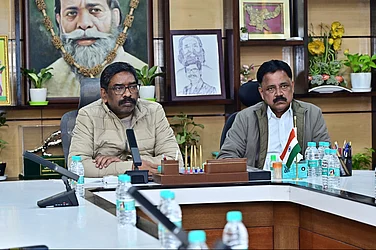Shown above is a smattering of headlines from a few mainstream news media in the immediate aftermath of the disastrous train accident on 2 June that took around 300 lives and left more than a thousand injured in Balasore, Odisha. The word that repeatedly comes up in all of them is ‘sabotage.’ According to Merriam-Webster, the word is defined as the “destruction of an employer’s property (such as tools or materials) or the hindering of manufacturing by discontented workers”. But its popular meaning points to a “deliberate subversion”.
Etymologically, the word finds its roots in the French saboter that means ‘to bungle’ or ‘to botch’. Interestingly, an oft-repeated story attached to the origins of the word takes it back to the days of labour unrest in early nineteenth-century France. To disrupt production work, the story goes that labourers would wear wooden shoes known as sabots and walk noisily, suggesting that ‘sabotage’ carries with it an intent to cause harm to the progress of either the state/employer or anybody who holds power.
Given that the CBI has already taken up the investigation to find the root cause of the train accident, a look at the preliminary reports could be useful. Within 12 hours of the accident, a joint-inspection team noted that prima facie, there was a signalling error that led to the incident. As per media reports, a green signal was given to the Coromandel Express but was soon taken off. However, within that gap, the train had already entered the loop line and rammed into a stationary goods train and got derailed.
The Making of ‘Sabotage’
On June 4, two days after the accident, Ashwini Vaishnaw, the Union Minister of Railways, said that the ‘criminals’ had already been identified, and gave instructions to the Central Bureau of Investigation (CBI) to take over the case. The investigative agency also took up the FIRs filed by the Government Railway Police (GRP) as it cannot collect any documents or material, question witnesses, record statements or conduct searches without it, as per PTI reports.
The vernacular television media also threw its hat into the ring to amplify the sabotage narrative. Suresh Chavhanke, editor of Sudarshan News, in a series of tweets, asked the National Investigation Agency to take up the investigation, with one of his programs titled ‘Hadsa or Hamla’ that means ‘Accident or Attack’.
However, before the investigation began, conspiracy theories were already being peddled by different social media accounts. On June 3, a day after the accident, the Twitter handle @randomsena posted a picture of the site with an arrow pointing to a white building with what looked like a tomb, and wrote “Just saying, yesterday was Friday”. It was immediately interpreted by Twitterati as an indication that the structure was a mosque and it was a Friday—the day when Muslims offer their weekly prayers—suggesting, therefore, that Muslims must be involved in the accident.
The tweet went viral and garnered 4 million views and around 4,500 retweets. On the same day, the handle posted another tweet that said, “Balasore is a hub of illegal Rohingya Muslims”. This tweet also got traction online and was viewed by 198.4k people at the time of writing. Fact-checking website Alt News, busted the communal rumour and noted that the white structure singled out in the first tweet was actually a temple run by the International Society for Krishna Consciousness (ISKCON). The Odisha police also took a note of the tweets, and in a statement said, “Severe legal action will be initiated against those who are trying to create communal disharmony by spreading rumours.”
Not the First Time
Notably, this is not the first time that the sabotage theory has been peddled following train accidents. In 2016, following the Kanpur train accident that took 152 lives, the railway ministry asked the NIA to take up the probe. In 2017, following another train accident in Kurenu, Andhra Pradesh where 40 people lost their lives, the NIA filed cases under the Ministry of Home Affairs and the Unlawful Activities Prevention Act (UAPA)indicating ‘Maoist’ hands behind it. However, neither probe has found evidence to prove the presence of sabotage, and the cases have not been chargesheeted to date.
When asked why people would subscribe to conspiracy theories that solely served the purpose of creating what sociologist Barry Glassner calls ‘a culture of fear,’ Sevanti Ninan, a senior journalist and the former editor of The Hoot, points to two possible reasons. “Firstly, it is the mischief-making proclivity of avid social media users and secondly, because of the polarisation that has set in.” Referring to the trend of sensationalising news, Ninan notes that the social media handles that peddle such rumours look for bad news—what she calls “scandal-mongering”.
But, how does social media shape the formal news discourse? “Mainstream media nowadays takes its cues from social media instead of going to the street to talk to the people. It looks to social media for opinion and says this is what the public is thinking,” says Ninan.
Sohini Sengupta, a professor at TISS Mumbai, notes that the phenomenon of ‘expert-bashing’ has been one of the major reasons behind the spread of misinformation in the last few years. It is mostly coupled with the sense of empowerment that people seem to find in using social media. “Everybody has a thirst to find out knowledge for themselves. But, the question hovers around whose version of reality is given priority,” says Sengupta. Discussing the sabotage theory, she says, “Everybody wants to know why it happened. Since the pandemic, the well-off sections of the society are always anticipating the next crisis. A ‘crisis thinking’ is involved in it.” People are also susceptible to certain forms of demonising in a polarised society, notes the scholar, referring to the blaming of Muslims for the accident.
Humanising Tragedy
At a time of rampant scandal-mongering, there were, nevertheless, voices of solidarity that immediately came to the rescue of the people involved in the Balasore train accident. Different media reports spoke of people who immediately opened up their grocery stores and provided survivors with the necessary medicines and food.
Reporting tragedy on the ground takes a different kind of skill and grit, and journalists across the world have been using different methods over the decades. After 9/11, the New York Times ran a series titled the ‘Portraits of Grief’ where they profiled more than 2500 victims of the terrorist attack in the form of impressionistic sketches. They focused on specific traits or talents of the victims and in a few words, made every life seem unique and extraordinary, as they are.
A study by Jennifer Aaker, social psychologist and professor at the Stanford Graduate School of Business, found that people tended to remember narratives and stories 22 times more than facts and figures alone. A significant example of such memory-making lies in how a gravedigger’s story was reported after the assassination of the then-US President John F Kennedy. While mourners thronged in front of camera, Jimmy Breslin, then a 33-year-old journalist, went to the Arlington National Cemetery to give a descriptive account of the old man called Clifton Pollard who was tasked with digging the deceased president’s grave.
In 2016, when the mass shooting occurred at Pulse, a gay nightclub in Orlando killing 49 people and injuring many others, the Orlando Sentinel chose to have the words “Our Community will Heal” on its front page instead of cluttering it up with data, facts and opinions. According to John Cutter, the then managing editor of the newspaper, they wanted to let people mourn the incident and heal while remaining optimistic about the future.
Human interest stories seem to have the potential to help readers not only remember the incident for longer but give them the optimism and hope that they lack in the face of utter tragedy. “The victims should not be reduced to numbers. The stories of solidarities and camaraderie should come up. I still believe in a world that lies beyond the hatred in social media,” says Sengupta.
(This appeared in the print as 'In a Culture of Fear')



























